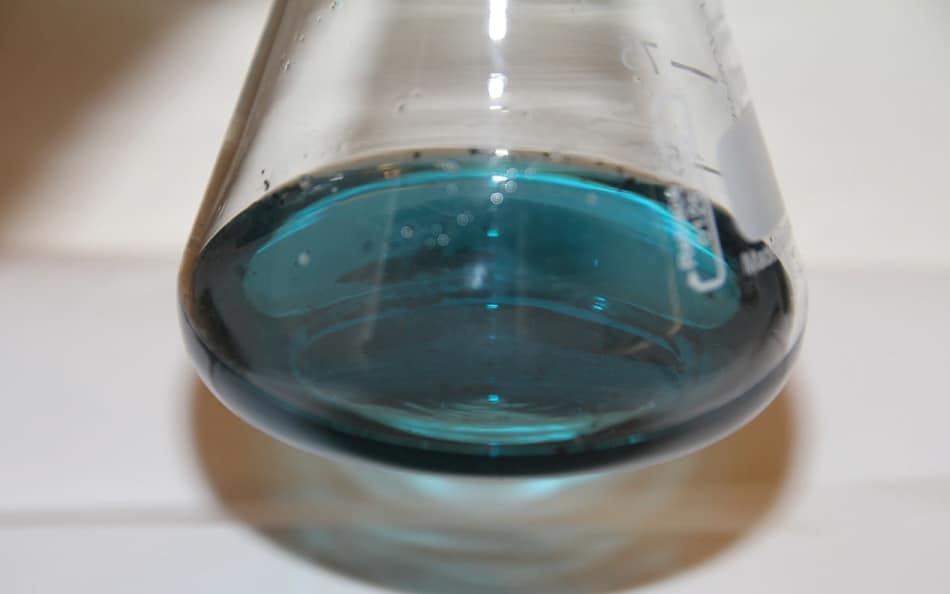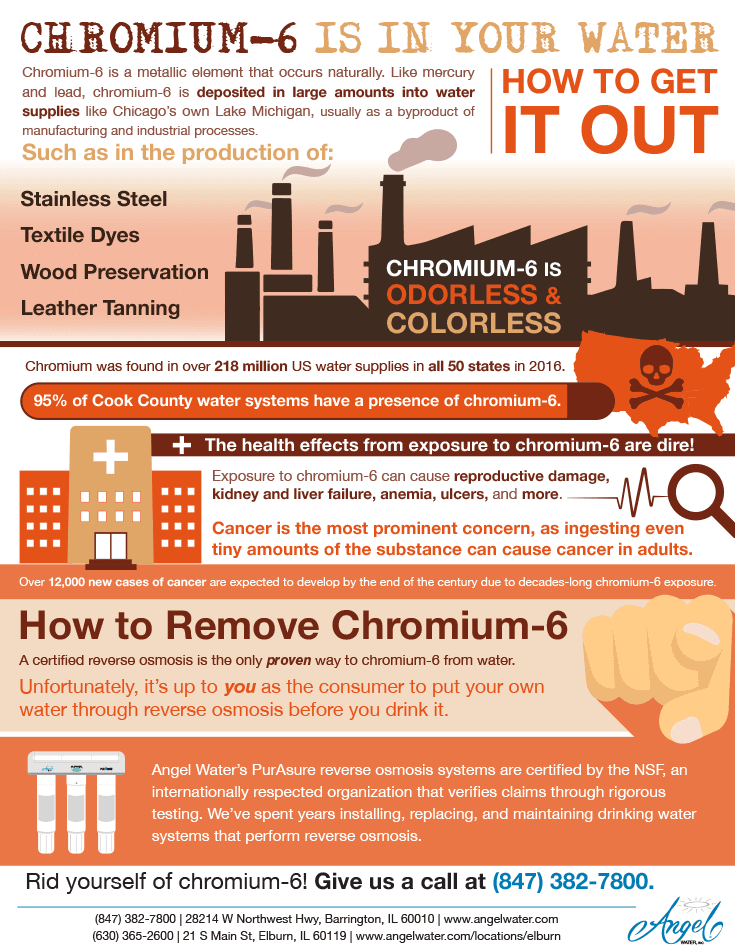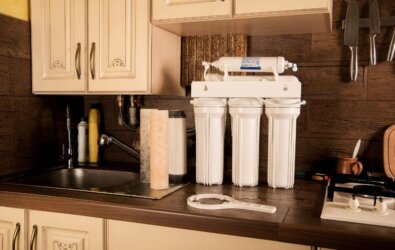How Reverse Osmosis Shields You from Erin Brockovich’s Chromium-6

The national standard for chromium is unenforced, because the policy was set in 1991, decades before research revealed how toxic this contaminant is. Political efforts to enact stricter regulations in recent years have failed because municipalities can’t afford the equipment and operation costs required to remove chromium at that scale at water treatment facilities. That’s why it’s up to you, the consumer, to protect yourself. A reverse osmosis system from Angel Water is independently certified by the NSF to remove all chromium-6 from your water, and is the most practical way to safeguard your family’s health.
If you’ve seen the movie Erin Brockovich, you may know a bit about chromium-6, the dangerous carcinogen that infested the water supply of Hinkley, California, leading to the $333 million class-action lawsuit chronicled in the film.
But do you know that you and your family are probably drinking that very same chemical in your own water?

That’s the word in a news release and petition recently put out by Brockovich herself in partnership with the Environmental Working Group (EWG). While many who are familiar with the chemical only through the movie think it’s an issue contained to that California town at that one time, as many as two-thirds of all Americans may currently have chromium-6 present in their water. Without reverse osmosis filtration, this chromium-6 is going right into their bodies—and likely yours, too—every day.
And yet, the EPA maintains no up-to-date national standard on acceptable chromium-6 levels in water supplies.
So what is chromium-6 and how much of a threat is it to your ability to drink healthy, clean water? Why isn’t it well-regulated? And how can reverse osmosis help?
How Widespread and Dangerous is Chromium-6?
Chromium-6, otherwise known as hexavalent chromium, is a metallic element that occurs  naturally only in small amounts. However, like other such elements including mercury and lead, chromium-6 is deposited in large amounts into water supplies like Chicago’s own Lake Michigan as a byproduct of processes carried out at pulp mills, steel mills, and other industrial facilities.
naturally only in small amounts. However, like other such elements including mercury and lead, chromium-6 is deposited in large amounts into water supplies like Chicago’s own Lake Michigan as a byproduct of processes carried out at pulp mills, steel mills, and other industrial facilities.
The documented health effects of exposure to chromium-6 are dire. Cancer is the most prominent concern, as ingesting even tiny amounts of the substance can cause cancer in adults. Reproductive damage, kidney and liver failure, anemia, ulcers, and more are other potential health risks of long-term exposure as well.
So how much is this carcinogen really present in American water systems? Very much so, as it turns out.
The EWG has just sent out a news release highlighting their new report that documents chromium in the water supplies of over 218 million Americans in all 50 states. According to the report, over 12,000 new cases of cancer will develop by the end of the century due to decades-long chromium exposure.
An interactive map displays the relative concentrations they discovered across the country. In Cook County, 81 out of 85 water systems detected the presence of chromium-6 in concentrations up to 1 part per billion (ppb). For comparison, this is fifty times California’s Public Health Goal of .02ppb, the concentration which scientists with the Office of Environmental Health Hazard Assessment (OEHHA) consider “protective against all identified toxic effects.”
So, in a word, you more than likely have chromium in your drinking water, and prolonged exposure over your lifetime can cause terrible damage, including cancer. What’s being done about it?
For starters, the release features a letter of support from Erin Brockovich herself, and leads to an EWG petition to the EPA to take action and establish enforceable chromium-6 regulations. Over 50,000 people have signed to date. But why doesn’t the EPA already have a strict standard in place if chromium-6 is so dangerous?
Why Is There No National Standard?
First let’s be specific about what guidelines do exist.
The current chromium limit of 100 ppb was set by the EPA isn’t technically federally enforced—according to the City of Chicago’s website for example, “there are no regulations or requirements to test for chromium-6 in drinking water.”
Want to get more helpful water information delivered to your inbox?
Sign up for our free email newsletter!
That’s because this standard hasn’t been updated since it was adopted in 1991. This was years before research into the effects of even small concentrations of chromium-6 discovered its true dangers.
At the time, it was thought that because most chromium-6 tends to convert to the inert chromium-3 in the human body, but we now know that chromium-3 and chromium-6 can freely convert back and forth in the body and in water, leading agencies to begin testing for total chromium rather than one or the other.
The 100ppb limit though was based only on what was known at the time, which is why it was set so far above the average concentrations shown in the EWG’s interactive map, which rarely go above 10ppb.
In other words, because we used to think it takes a lot of chromium-6 for there to be health hazards, the limit is set so high that there effectively is no regulation.
And yet there has been no change in regulation to reflect our newfound understanding, despite efforts on the part of concerned health experts who have been pushing for far lower acceptable maximum concentrations for chromium.
Scientists in California put their Public Health Goal at .02ppb. There was then a campaign to establish a statewide legal limit of 1ppb, but after water companies and municipalities exerted a lot of political pressure the new limit was set at 10ppb—500 times the concentration at which scientists say there are no toxic effects.
These struggles have played out in other states as well with even less success. Scientists in New Jersey and North Carolina both pushed for .06ppb legal limits in their respective states, but politically appointed regulators blocked their recommendations and no standard has been adopted in either state.
Why? Well, as is often the case, money is the root of the problem.
Removing chromium from municipal water supplies requires lots of expensive large-scale reverse osmosis equipment and labor—reverse osmosis facilities either retrofitted or built from scratch, machinery brought in, maintenance workers hired, etc.
In fact, while deciding what to set as their limit, California estimated that the cost of initial set up to get water systems into compliance with a limit of 1ppb would be $21 billion, whereas for a limit of 10ppb it would be only $3.1 billion.
That’s why not only water companies but also municipalities push back against efforts to establish these regulations. If the EPA did try to establish a national standard as low as the research suggests it should be, it’s hard to imagine that many cities at all would be able to comply. Cash-strapped Illinois certainly would have a particularly tough time swallowing an expenditure of tens of billions of dollars.
And so, rather than enact a regulation that no cities can comply with due to the astronomical expense of it, the EPA has chosen to keep the old standards, regardless of how inadequate we now know them to be.
Removing Chromium-6 With Reverse Osmosis
Reverse osmosis is the only reliable and proven way to remove chromium from water. But, as we’ve seen, we won’t be getting reverse osmosis from our cities anytime soon.
So if performing reverse osmosis at the water treatment plant for everyone who gets their water from that supply is too expensive, it’s up to you as the consumer to put your own water through reverse osmosis before you drink it.
You can’t just get any system though—with so much misinformation in the industry, you need to know that your equipment is independently certified to actually perform the reverse osmosis as well as it claims it does, and that the contractor installing it is trained and experienced in working with that type of system.
Angel Water’s EcoWater reverse osmosis drinking water systems are certified by the NSF, an internationally respected organization that verifies claims through rigorous testing, and we’ve spent years installing, replacing, and maintaining drinking water systems that perform reverse osmosis in Barrington, IL and the surrounding area.
So to rid yourself of chromium and make sure that crisp, clear glass of water in your home is truly safe, give us a call at (847) 382-7800. Erin Brockovich is playing out in real-time all around us—make sure you aren’t another helpless extra.
Interested in a Water Softener System for Your Home?
You don’t have to live with a dry, itchy scalp and brittle hair anymore! It would be our pleasure to help you find the right water softener to make your showers enjoyable again.
Please give us a call at (847) 382-7800 or visit our water softener page to learn more.



